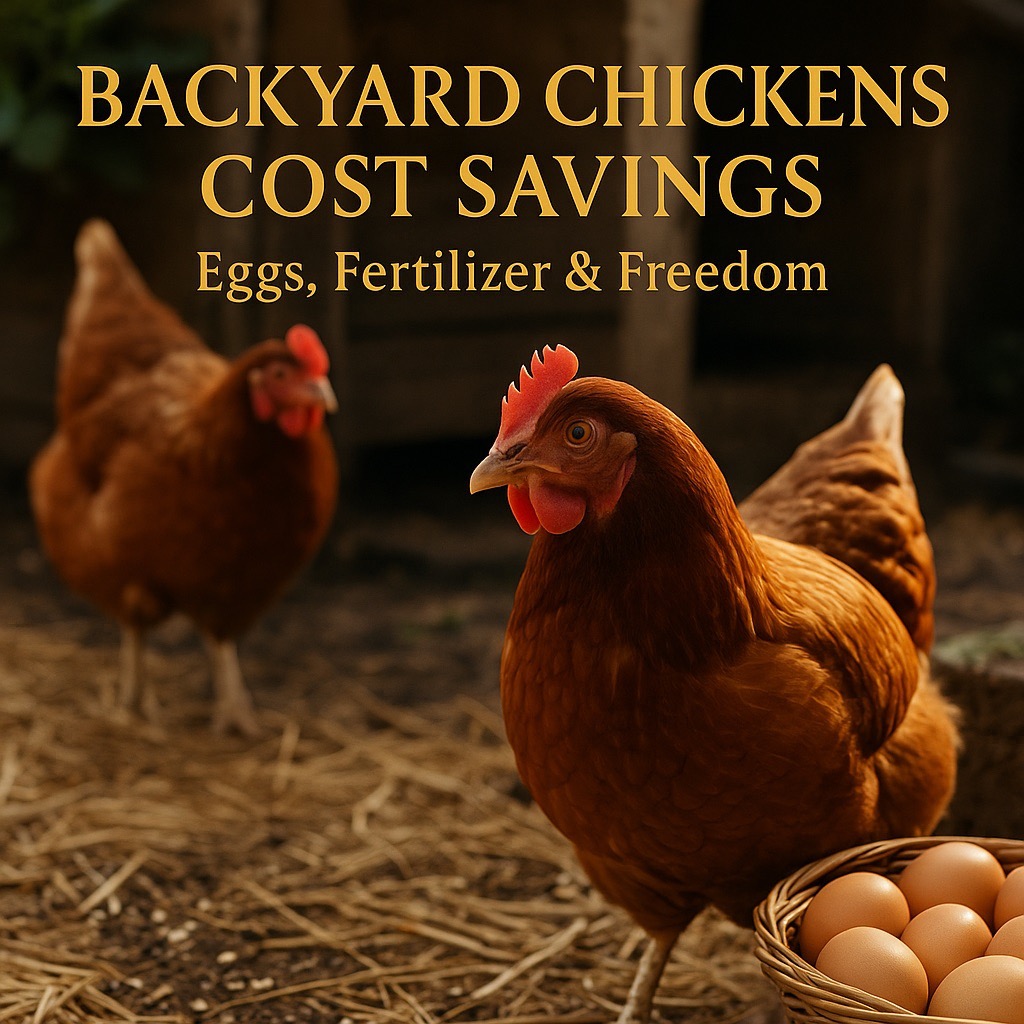Backyard chickens cost savings are more real than most people think. In today’s economy, every dollar matters — and keeping a small flock of hens can lead to surprising financial benefits. From egg production to composted fertilizer and food waste reduction, backyard chickens deliver serious savings while creating food security and independence.
Backyard chickens and cost savings go hand in hand. From eggs to fertilizer to reduced household waste, your flock helps your wallet as much as your garden.
Let’s break down the real numbers — and the deeper value they represent.
🍳 Egg Savings from Backyard Chickens: Daily Protein, Lower Grocery Bills
A single hen lays between 200–280 eggs per year, depending on breed and environment. That means:
- 3–5 hens = 12–18 eggs/week
- That’s roughly 600–900 eggs/year
- At $4/dozen = $200–$300+ saved annually
Bonus: You’re getting fresher, more nutritious eggs — no additives, no long-distance shipping, no price spikes from supply chain disruptions.
And in a food emergency? You’ve got protein on tap, right in your backyard.
🌱 Compost & Fertilizer Savings with Backyard Chickens
Chicken manure, once composted, is rich in:
- Nitrogen
- Phosphorus
- Potassium
Store-bought organic fertilizer can run $10–$20 per bag — but your chickens produce it for free.
- 4 hens = enough manure to fertilize a small garden all year
- Saves $50–$100/year in soil products
- Promotes stronger yields = more food grown at home
This isn’t just savings — it’s soil sovereignty.
🗑️ Waste Reduction: Trash Costs Down, Utility Up
Food scraps make up 20–40% of household waste — and chickens love them. Instead of tossing leftovers, you:
- Feed your flock
- Reduce bin volume
- Skip trash bags
- Cut compost overflow
Over time, this means fewer disposal fees, less plastic, and a more sustainable rhythm in your home.
“Gather the leftovers, so that nothing is wasted.” — John 6:12
🛡️ Economic Resilience: A Backyard Food Buffer
In times of inflation, recession, or instability, homegrown food becomes a financial asset:
- Eggs = daily protein
- Manure = soil input
- Chickens = barter opportunity
- Scraps = zero-waste input
Backyard chickens turn your yard into a micro food system. That’s savings you can eat — every single day.
🧠 Frequently Asked Questions About Backyard Chicken Costs & Savings
Q: What is the real yearly cost to raise backyard chickens?
For a flock of 3–5 hens, here’s a realistic annual estimate:
- Feed: $12–$18/month = $144–$216/year
- Bedding (e.g., pine shavings or straw): $5–$10/month = $60–$120/year
- Supplies (feeders, grit, oyster shell, etc.): ~$100/year
- Coop (amortized over 3–5 years): ~$60–$100/year
➡️ Total annual cost: $350–$500
➡️ Estimated savings in eggs/fertilizer/waste: $300–$500+
🟢 Net result?
Most families break even in the first 1–2 years. After that, chickens pay for themselves and become a consistent source of economic and food security.
Q: Are backyard chickens profitable — or just cost-effective?
Both — depending on your goals.
Backyard chickens are cost-saving by default, but they can also generate side income through:
- Surplus egg sales to neighbors or at farmer’s markets
- Composted chicken manure as organic garden fertilizer
- Selling chicks or started pullets to new chicken keepers
- Hosting backyard tours, workshops, or “chicken camps” for kids or local gardeners
💡 Many homesteaders use chickens as an entry point for micro-enterprise or skill-sharing ministries.
Q: Do local ordinances limit how much I can save with chickens?
Sometimes — but usually not enough to eliminate the benefits.
📝 Most urban and suburban areas allow:
- 3–6 hens (no rooster)
- Backyard coops with size or distance regulations
- Egg sharing or small-scale sales (within health guidelines)
Before you start, check your:
- 🏙️ City zoning laws or HOA rules
- 🐓 Rooster bans (hens don’t need roosters to lay!)
- 🧾 Permits or labeling requirements for egg sales (varies by state)
Even with limits, a small flock of 3 hens can still provide:
- 600–700 eggs per year
- $150–$250+ in egg savings
- $50–$100 in compost/fertilizer value
- Reduced grocery trips and waste
Q: What hidden costs should I prepare for?
While chickens are affordable, consider these occasional or one-time costs:
- Predator-proofing upgrades (hardware cloth, secure latches)
- Health supplies (vitamins, dewormers, vet visit in rare cases)
- Heat lamps or insulation in colder climates
- Time investment — daily care takes 5–15 minutes
However, many keepers find that the value goes beyond money — offering routine, peace, connection to nature, and confidence in hard times.
📚 Related Articles on Paranoid Prophet
- ✅ Benefits of Raising Backyard Chickens
- ✅ Backyard Eggs vs Store-Bought
- ✅ Backyard Chickens Sustainability
📚 Related Reading
- The Economics of Raising Chickens: Cost Breakdown and Savings
Explore a detailed analysis of the costs associated with raising chickens and how they can lead to significant savings on groceries and fertilizers. - Is Raising Chickens Actually Cheaper Than Buying Eggs? Chicken Keepers Weigh In
This article discusses the financial aspects of chicken keeping, comparing the costs to purchasing eggs and highlighting the long-term benefits. - The Real Cost of Backyard Eggs
An in-depth look at the hidden costs and considerations of producing your own eggs versus buying them from the store. - The Many Benefits of Backyard Chickens
Beyond cost savings, this piece delves into the environmental and lifestyle advantages of keeping backyard chickens. - How Much Does It Cost To Raise Chickens?
A comprehensive guide breaking down the monthly and yearly expenses involved in maintaining a backyard flock.
✝️ Final Thought
Whether you’re saving on groceries or building a micro-homestead, the backyard chickens cost savings are undeniable — practical, measurable, and spiritually grounded.
Chickens aren’t just clucking companions — they’re a divinely designed food engine. They eat what you’d waste. They give what you can use. And they remind us that God’s economy isn’t built on endless spending — it’s built on stewardship.
When the world gets unpredictable, a hen is a hedge.




